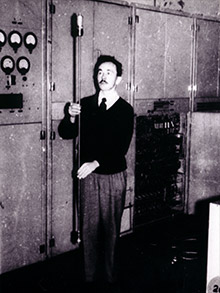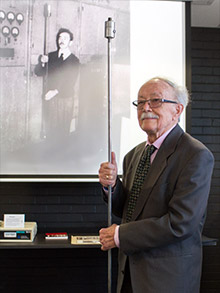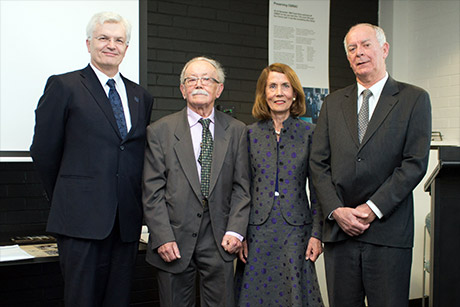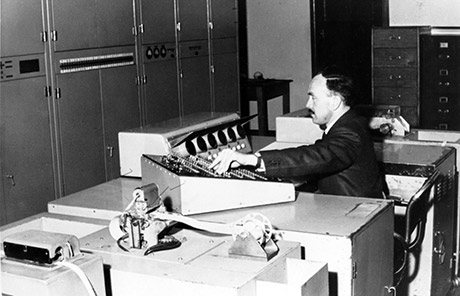

Jurij Semkiw was born in Ukraine in 1929. His family, displaced from their home by the Second World War, travelled across Europe to Germany, where Jurij matriculated. They ultimately reached Melbourne by ship in 1949. On arrival at Station Pier they were immediately transferred by train to Bonegilla migrant hostel. As displaced persons, they were bonded workers for two years. The family was split up and Jurij was sent to work in the bush as a timber worker.
Jurij later moved to Melbourne, where he studied electronics at the Royal Melbourne Technical College and worked with the Department of the Army and the Department of Civil Aviation, building, testing and maintaining communication equipment.
When Jurij arrived in Australia in 1949, despite frantic efforts in England and USA, only one programmable electronic computer had operated anywhere in the world. That was at the University of Manchester. However, by the end of 1949, Cambridge had also built a programmable computer, there was one nearing delivery in USA and, most remarkably, the CSIR (later CSIRO) in Sydney had designed and were testing a computer they called (very imaginatively) the CSIR Mk 1. The designers of that computer, Maston Beard and Trevor Pearcey, were the founding fathers of the digital age in Australia.
Five years later, the CSIR Mk1 was still the only computer in Australia when the University’s formidable Professor of Mathematics Sir Thomas Cherry FRS, arranged for it to be transferred to Melbourne. The huge computer came down the Hume Highway on a semitrailer.
In August 1955, Dr Frank Hirst recruited Jurij Semkiw as a founding member of the new Computation Laboratory in the Natural Philosophy Building at The University of Melbourne. Jurij was to assist with the task of reassembling and commissioning the newly arrived machine. Jurij worked with Ron Bowles, the senior maintenance engineer. Together they maintained and developed what was, at the date of its re-commissioning, still the only computer and the largest electronic machine in Australia. It was re-launched in June 1956 and named CSIRAC.
Even before the computer was relaunched, computing courses were commenced. Thus this University established the first academic computing department in Australia and one of the very first in the world. We also provided the first computing service in Melbourne for research workers, for CSIRO, and for local companies.
For the next eight years the computer was used for numerous projects. It helped design our electricity grid, design some of Melbourne’s buildings, do calculations for research projects in engineering physics and forestry, and even calculated staff loan repayments. Many people who went on to lead our efforts in the computing field started with CSIRAC. Among the researchers who relied on Jurij Semkiw and Ron Bowles to keep the computer running was a young meteorologist, Dick Jenssen. He programmed the computer to produce some of the earliest numerical weather forecasts in the world. He also programmed it to play computer games.
During his time in the Computation Laboratory, Jurij also designed and constructed some of the earliest xerographic photocopying equipment in Australia, which was far in advance of alternative contemporary methods of duplicating documents. He designed and built early transistor-based circuits that enabled the disk store of CSIRAC to be doubled in capacity. Jurij was also a founding member of the Victorian Computer Society established by Professor Cherry, Trevor Pearcey, Frank Hirst and others, which evolved to become the Victorian Branch of the Australian Computer Society — the recognized national professional organisation in the IT sector.
By 1964 CSIRAC was the oldest computer still operating. Jurij was the person who dismantled and labelled the CSIRAC hardware when it was decommissioned and sent to the Applied Science Museum in 1964.
The University had by then acquired a transistorised IBM computer of vastly greater capacity and speed. Jurij helped operate that as the new technology became available to staff across the campus and across the disciplines. Thousands of students had their first experience in programming a computer at that time. Use of computers spread to almost all areas of research, and new users had to grapple with the new technology. He also continued to develop computer equipment to support our research.
When in 1970 it was decided to separate the academic department from the computing service, Jurij stayed with the academic department. For the next thirty years, Jurij continued to work with academic staff to design and implement a wide range of leading edge computer-related hardware projects. Research students could rely on Jurij to enhance departmental minicomputers, and to design and build equipment which would underpin their research.
In the 1970s, Professor Peter Poole, the foundation Professor, foresaw the flexible open systems computing environment and connectivity that we rely on today, and supported numerous projects to interconnect diverse computing systems. Jurij Semkiw was the lead engineer in many of these projects.
This expertise in computer networking enabled the Department to work with the Computer Centre and position the university as a preeminent interconnected campus. National surveys at that time placed this university second only to the major government departments and the banks in adoption of the new technology.
Jurij was our senior technical staff member at the time another technical staff member Robert Elz emerged as a world figure in the development of the Internet. Robert was instrumental in establishing the academic email systems that all Australian academic institutions came to depend on, and led to the introduction of the Internet to Australia. Robert was supported in this role by the Department, and used one of our interconnected computers to establish the first Australian Internet services. This leading position that meant that for a number of years the whole of the Internet service to Australia and other countries in the region depended upon facilities provided in this department and overseen by Robert Elz. Indeed the very first Internet interchange in Australia took place in the Richard Berry building.



The international Internet body gave Robert the task of administrating the whole of the domain name allocations for Australia. He did this for several years before it was sold to commercial interests. Robert gained no financial reward from this transaction, but his contribution was recognised in 2013 when he was formerly inducted into the Pearcey Hall of Fame. The Pearcey awards, established by Ian Dennis after the death of the father of Australian computing Dr Trevor Pearcey, are the pre-eminent National Awards in the ICT field.
Joint work between Jurij, Robert Elz and others including Steven Lynch and Michael Flower, resulted in the development of the Unison Computer system that was marketed locally and overseas. A subsequent success was the Multigate, which was proposed by Jurij and developed by him and departmental software engineers and licensed to a Melbourne manufacturer. The product was sold here and in the US. Indeed Apple purchased them for its own offices. This development earned significant royalties for the university. Jurij also developed hardware for Dr Barry Conyngham and Dr Rex Harris in their pioneering work in Computer generated music.
Jurij’s career and knowledge moved from vacuum tubes in 1955 to transistors, to integrated circuits, to modern processor chips; mastering each successive generation of technology for forty years. He rode the wave of the fastest technological revolution in human history. It has been said that the problem with most people who have an infinite capacity for taking pains is that, having taken pains, they then give them to everyone else. This has never been so with Jurij. Former staff members describe him as the best boss they ever had.
Jurij officially retired in 1994, after almost 40 years full-time employment in the departments springing from the original Computation Laboratory. However, he maintained his association with the university even after stepping in to retirement.
In 1996, the then Head of Department, Peter Thorne (one who worked under Jurij maintaining CSIRAC during the 1960s) initiated a project to record the history of computing and the department. Collaborators in this have been Dr Doug McCann and Judith Hughes. With Ron Bowles (now deceased), John Spencer, and our colleagues at Museum Victoria, Jurij was a crucial participant in the successful efforts to reconstitute CSIRAC, now the oldest intact stored-program computer in the world, for permanent display in the Melbourne Museum.
As a result, the importance of those early Australian achievements is now recognised internationally. The installation has been awarded Heritage status by Engineers Australia and Heritage Victoria. It has starred on BBC TV several times and even on Russian TV.
Jurij, John Spencer Ron Bowles and staff member John Horvath also played a major role in the successful project to re-create the music of CSIRAC, perhaps the world’s first computer generated music. This project was initiated by Dr Paul Doornbusch when he was at the conservatorium at The Hague and has received international acclaim.
Jurij still attends the Department each week. He has developed and is maintaining a database of the historic items and documents which form the departmental heritage collection. Jurij’s association and contribution has continued unbroken since 1955.
In October 2013 Jurij’s exceptional contributions to computing in the University and in Australia were recognised by the award of the University’s Gold Medal, presented by the Chancellor, Ms Elizabeth Alexander AO, in front of an audience that included the Vice-Chancellor, Professor Glyn Davis AC, six current or former Heads of Departments associated with computing at the University, past and current Presidents of both the Pearcey Foundation and of the Victorian Branch of the Australian Computer Society, a large number of current and ex-colleagues, and members of Jurij’s family.
Relic from birth of computer age, The Age, October 2, 2013 (Includes video interviews)
These notes are an edited version of a presentation made by Peter Thorne at the Gold Medal Award ceremony held in the Department of Computing and Information Systems on 7 October 2013.